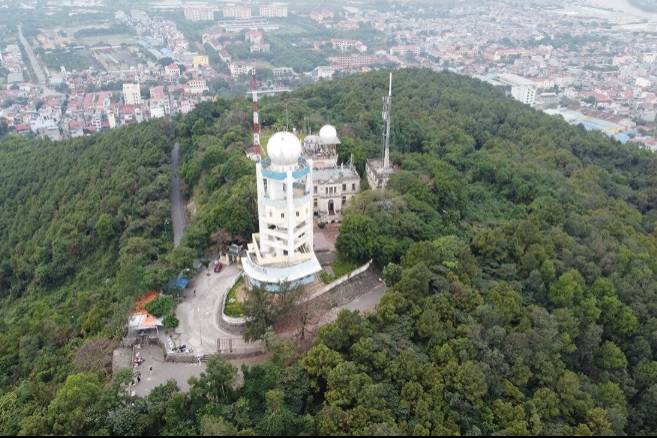Viet Nam's hydrometeorological sector has established cooperation with numerous countries and international organizations, improving forecast quality and enhancing the country's ability to respond to increasingly severe and transboundary weather hazards.
The world's temperature is rising
According to Mr. Mai Van Khiem, Director of the National Center for Hydrometeorological Forecasting, the projected impacts of climate change are now becoming a reality. Over the past decade, every year has ranked among the hottest on record. Ocean temperatures have broken historical documents, and extreme weather events, including heatwaves, floods, severe storms, and super typhoons, affect nations worldwide.
"The Earth is warming at an alarming rate, as reflected in increasingly dire statistics," Mr. Khiem emphasized.
A report from the World Meteorological Organization (WMO) highlights that between 1970 and 2021, extreme weather events caused nearly 12,000 disasters, resulting in 2 million deaths and $4.3 trillion in economic losses. Despite these staggering numbers, almost half of the world's countries still lack comprehensive early warning systems. This leaves millions of people exposed to natural disaster risks without timely information to respond effectively.
Recognizing this gap, the United Nations launched the "Early Warnings for All" (EW4All) initiative to ensure that by 2027, every person on Earth has access to disaster early warning systems.
The theme of World Meteorological Day 2025 (March 23)—"Closing the Early Warning Gap Together"—underscores the urgent need for global collaboration. The message calls for stronger partnerships among stakeholders to develop more integrated, resilient, and effective early warning systems, ensuring that no one is left behind in the growing climate threats.
 The national hydrometeorological monitoring network currently consists of more than 217 surface meteorological stations.
The national hydrometeorological monitoring network currently consists of more than 217 surface meteorological stations.Viet Nam’s effort to strengthen early warning system
Viet Nam is among the countries most affected by climate-related disasters, including storms, floods, and droughts. As a result, hydrometeorological forecasting is not just a technical task but also carries a crucial mission to protect lives and property.
Mr. Ma Van Khiemm, Director of the National Center for Hydrometeorological Forecasting, affirmed that hydrometeorological forecasting and early warning serve as the first line of defense against natural disasters. Thanks to the attention and investment from the Party, the State, and the Government, Viet Nam's early warning system has made significant progress.
The national hydrometeorological monitoring network currently consists of more than 217 surface meteorological stations, nearly 2,000 automatic rain gauges, 426 hydrological stations, 27 marine meteorological stations, and 10 modern weather radar stations. This system helps monitor, track, forecast, and promptly warn of dangerous weather phenomena such as typhoons, floods, droughts, and saltwater intrusion.
Viet Nam has applied advanced technologies to enhance forecasting capabilities. These include the Cray XC40 supercomputer, which strengthens forecasting capacity and the assimilation of satellite, radar, and surface observation data, improving the accuracy of heavy rainfall, flash floods, and landslide predictions. The flash flood and landslide risk warning system has been detailed down to the district level, helping authorities and local people proactively respond.
“Timely and accurate forecasts have helped functional agencies and people actively respond, minimizing damage. To achieve this, the National Center for Hydrometeorological Forecasting has received cooperation from various agencies and experts within and beyond the hydrometeorological sector.
Within the Hydrometeorology Administration, the center has closely coordinated with affiliated units such as the Monitoring Center, the Information and Data Center, and regional and provincial meteorological stations. This ensures data synchronization and accuracy. "Certainly, the value of a forecast report does not rely solely on modern analytical methods but also the quality of observational data and the coordination between units within the system. Without comprehensive observations and accurate data, even the most advanced forecasting models cannot produce useful reports for the people," Mr. Khiem shared.
Multilateral Collaboration
On the international front, the National Center for Hydrometeorological Forecasting of Viet Nam has established partnerships to share forecasting data with meteorological agencies in Japan, China, the Philippines, Europe, and the UK Met Office. This collaboration not only enhances forecast accuracy but also improves capacity to respond to transboundary extreme weather events. A notable example is Typhoon Yagi in 2024, where data sharing between the China Meteorological Administration (CMA), the Japan Meteorological Agency, and the Viet Nam’s National Center for Hydrometeorological Forecasting significantly improved the accuracy of storm track and intensity predictions. This allowed authorities and residents to prepare in advance, minimizing damage.
Domestically, the center benefits from strong cooperation with organizations beyond the Hydrometeorology Authority, such as the Viet Nam Meteorological and Hydrological Association, the Department of Water Resources Management, the Institute of Meteorology, Hydrology, and Climate Change, the Department of Dike Management and Disaster Prevention, and the Rescue and Relief Department. These collaborations facilitate the exchange of scientific knowledge, data integration, and coordinated disaster response efforts, strengthening forecasting capabilities and early warning systems.
Additionally, media and press agencies are critical in swiftly and accurately disseminating forecast information to local communities. Their involvement ensures that meteorological updates go beyond technical bulletins, transforming into actionable guidance that helps authorities and citizens proactively respond to natural disasters and mitigate risks.
As the Secretary-General of the World Meteorological Organization emphasized, national meteorological and hydrological professionals work much like doctors and nurse, operating around the clock to safeguard lives and support societal resilience. By working together, we can build a hydrometeorological service that not only addresses today’s challenges but also anticipates and prepares for the uncertainties of future weather events.
2025 is likely to rank among the hottest years ever recorded, with the global average temperature potentially exceeding 1.29-1.53°C above pre-industrial levels. In Viet Nam, temperatures are expected to remain high, but it is unlikely to break the record set in 2024. The ENSO phenomenon is transitioning from La Niña to a neutral state by mid-year, which could increase the risk of heavy localized rainfall, urban flooding, flash floods, and landslides. The South China Sea may experience 11-13 storms, with 5-6 directly impacting the mainland. The likelihood of intense storms, with wind speeds reaching level 12 or higher, remains high. |